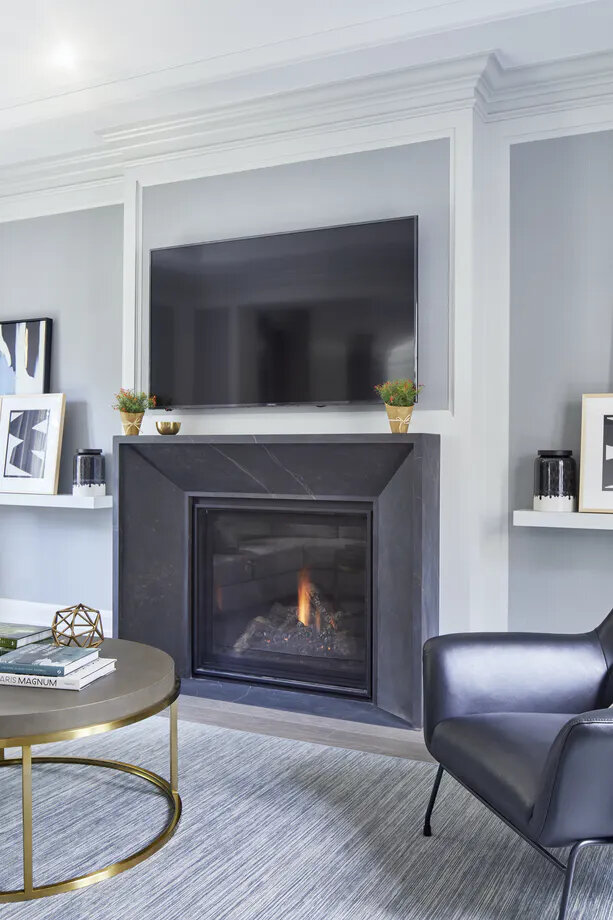How to Pick the Best Stone for Fireplaces
Photo: Kelya Dekton Fireplace
Photo Courtesy of: Cosentino
Fireplaces add a sense of comfort and warmth (quite literally) to any home. Choosing the right type of stone for your fireplace can help create a warm and inviting feeling for your family and visitors and improve the overall look of the space.
In this guide, we’ll discuss the best way to select a stone for your fireplace, and what you should consider when looking to do a fireplace renovation.
What Should You Consider Before Selecting a Stone?
There are a few things to consider before you decide what type of stone you’d like to feature on your fireplace.
What aesthetic are you going for?
Fireplaces can have many different looks. Are you going for an aesthetic that is modern and sleek? Are you more of the rustic type? Or do you require a certain level of elegance to match the rest of your home?
Once you’ve decided on the look and aesthetic of your new stone fireplace, you can then start thinking about other factors.
READ MORE: How Fireplace Decor Can Warm Up Your Home
Who is doing the work?
It’s important to consider who will be doing the work when it comes to your stone fireplace installation. While some projects are DIY, in the case of working with large slabs of solid stone, the work is usually best left to professional stone installation experts.
By hiring professionals to install your stone fireplace, you can rest assured that your project will be completed safely and correctly.
What is your budget?
Your budget will always play a role when considering which type of stone you can use for your fireplace. As with all things, the price of stone can range from budget-friendly to luxury.
Another thing to consider when budgeting for your project is the cost of hiring a professional (which we strongly recommend when working with large, heavy slabs of stone).
Will the stone require maintenance?
When considering a stone fireplace, you should do your research on the maintenance and durability of the type of stone you’re looking for.
Certain types of stone have a beautiful aesthetic, but may require a lot of maintenance. Other types of stone may also look nice, but require much less maintenance.
This consideration is more of a personal choice than anything. Finding the balance between beauty and maintenance is a very personal decision. Some people don’t mind performing maintenance, while others do. The choice is completely up to you and there is no right or wrong decision.
Types of Stone for Fireplaces
There are many different options to choose from when trying to find the best stone for a fireplace.
Natural Stone
Natural stone is a very popular material for fireplace surrounds for a number of reasons. Because the fireplace is often the main focal point of the room, it is important to have an aesthetically pleasing stone that matches the overall look and feel of the house.
In addition to being very versatile design-wise, natural stone also offers a very high level of durability. Natural stone surfaces are generally tolerant of heat and have very hard, scratch-resistant surfaces. Natural stone is a great choice that can withstand the rigours of everyday use.
Granite
Granite is the most popular choice for a stone fireplace surround. It is one of the most durable and long-lasting types of stone you can buy.
Granite is extremely durable with its scratch-resistant surface. Granite is also very unlikely to crack or chip, and it has a good level of heat tolerance. Granite is suited for gas or wood fireplaces.
Since granite is a very popular type of stone, there are hundreds of unique colours and patterns to choose from. The versatility and durability of granite makes it a great choice for any fireplace surround, no matter the setting.
Marble
While slightly more expensive than granite, and not quite as durable, marble has a unique and timeless beauty about it, which makes it another popular choice for fireplace hearths.
Marble is often associated with luxury and elegance, and definitely offers a high level of aesthetic appeal to more luxurious spaces.
Marble has an excellent level of heat tolerance and is suitable for gas, wood, or electric fireplaces.
Marble does usually require more maintenance than granite, however. When cared for properly, it rarely suffers from cracks, chips, or stains. Often being offered in lighter colours, it will also require more frequently cleaning than most granite fireplaces.
Limestone
Limestone isn’t for everyone, and it doesn’t fit the aesthetic of every home, but it does offer a very earthy and rustic feel to spaces that would benefit from it.
Limestone is a more budget-friendly stone option with good heat tolerance and durability. Despite this, limestone should only be used for gas and electric fireplaces - not wood burning fireplaces.
Limestone does require sealing to prevent stains, but is very durable when otherwise cared for properly.
In terms of colours, limestone often comes in neutral palette colours, like cream, tan, light browns, whites and grays.
Slate
Slate is a very durable and hard material. It often comes in darker colours, like grays, blacks, greens, and reds. In terms of budget, slate requires a bit more of an investment than a limestone fireplace, but less than a granite or marble fireplace.
Given the fact that slate is a naturally “uneven” stone surface, it offers a more rustic look.
Heat from a wood burning fire may be too intense for slate, but it otherwise is appropriate for gas and electric fireplaces.
Engineered Stone
Engineered stone, like Dekton by Cosentino, is another very popular choice for fireplace hearths and surrounds.
Dekton is an extremely scratch-resistant surface, and is even more resistant to abrasion than granite (which is very durable).
Being a nonporous surface, Dekton is also highly resistant to staining, which means stains from things like rust and chemical cleaners can be removed very easily.
Dekton has an excellent resistance to high temperatures without compromising on aesthetics or features, which makes it a suitable choice for gas and electric fireplaces, along with the high temperatures of wood burning fireplaces. Hot utensils, like fireplace pokers, can be placed directly on the surface without causing any damage to it.
Dekton is also highly resistant to ultraviolet (UV) rays, giving it superior colour stability that doesn’t fade over time. It is a perfect choice for both interior and outdoor applications.
Dekton surfaces have a low thermal expansion coefficient, making it resistant to thermal shock. This means that Dekton can go from extreme cold temperatures to very hot temperatures without causing any damage to the surface.
On top of the incredible durability, Dekton is available in over 60 different colours to match your own unique preference.
Create a Unique and Inviting Space with a Stone Fireplace
As you can see, there are a lot of options when it comes to choosing the best stone for a fireplace. Budget, aesthetic, and material are all decisions that can be tough to make.
Out of all of these difficult decisions, there’s one easy one: contacting the experts at Stoneworx today to book your free consultation on how to bring your design vision to life.

